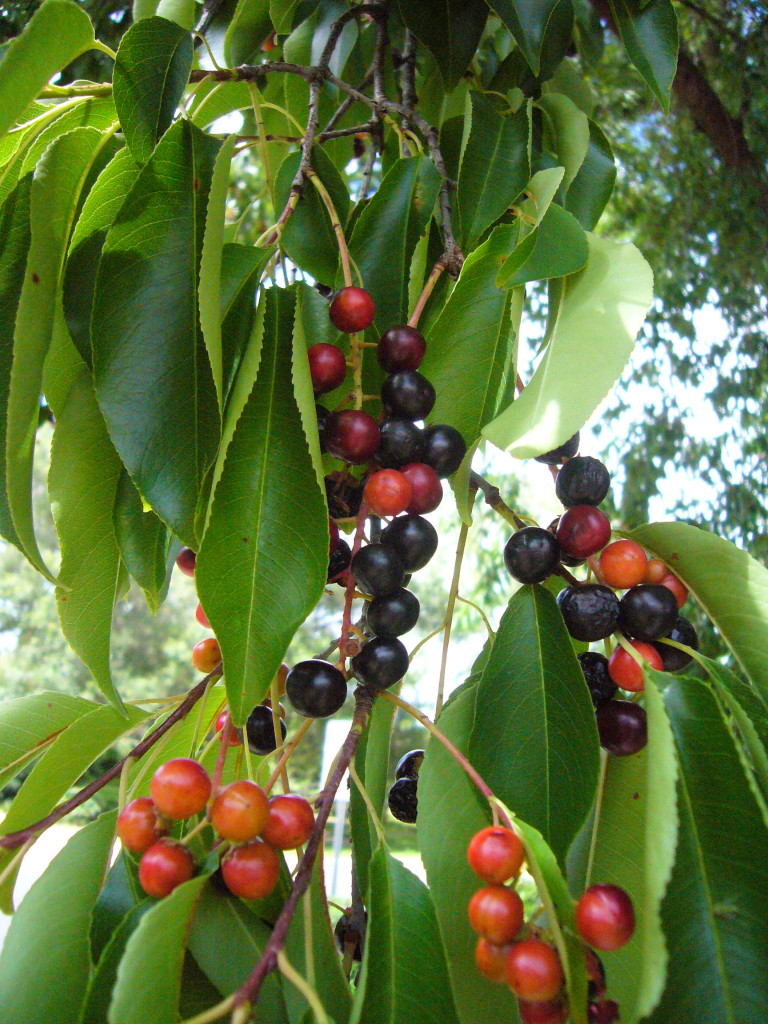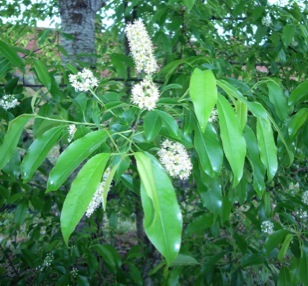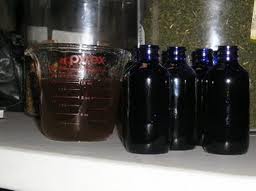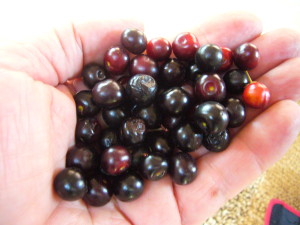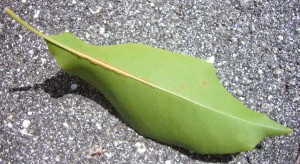Prunus serotina: Better Late than Never Cherry
Think of the Black Cherry as a chokecherry with some of the choke removed… some…
Not a 100 feet from the house I grew up in there was a stand of chokecherries (Prunus virginiana, PROO-nus vir-jin-nee-AY-nuh.) It was always a challenge to put in perspective their abundant beautiful cherries with their sharp astringent taste. Of course fermentation helped that a lot and chokecherry wine was a favorite of mine. Fortunately the Black Cherry does not throttle you as much as the chokecherry, but it grabs a little. In between those two is the pin cherry.
Here in central Florida the most common edible cherry we see is the Black Cherry, Prunus serotina (sair-OTT-ih-nuh) though it grows throughout the eastern half of North America, lower parts of New Mexico and Arizona then south into Mexico and beyond. It has been naturalized in Europe. It’s easy to identify. Look at the back of several leaves. On other than a new leaf the mid-rib underneath will have hair on either side near the stem, blond when young turning rust colored to black when old. See photo below.
Florida is the end of its Black Cherry’s range. Often its leaves are more lance shaped here than usual and can resemble the pin cherry (Prunus Pennsylvania) which does not grow this far south. So if you’re in Florida and you see a bird picking a little cherry it’s an odds on favorite to be the Black Cherry. Unlike the chokecherry, the Black Cherry is a favorite native tree. It has been used for food, woodworking and landscaping. Its inner bark has been concocted for centuries to make a cough syrup. While the Black Cherry makes a fast-growing attractive landscape tree, it is sometimes skipped over because it drops cherries and formal gardeners often don’t like that, though the birds and animals do.
Black Cherry fruits are important food many birds and mammals. Numerous songbirds feed on Black Cherries as they migrate particularly farther north in the fall. Among the birds who favor the Black Cherry are the American robin, brown thrasher, mockingbird, eastern bluebird, European starling, gray catbird, blue jay, willow flycatcher, northern cardinal, common crow, waxwings, thrushes, woodpeckers, grackles, grosbeaks, sparrows, and vireos. Black cherries are also important in the diets of the ruffed grouse, sharp-tailed grouse, wild turkey, northern bobwhite, and greater and lesser prairie chicken. Animals that like the fruit include the red fox, raccoon, opossum, squirrels, rabbits and bears. White tail deer eat the leaves and twigs. Clearly a tree to watch if you want to see wild life.
While the fruit is popular the leaves, twigs, bark, and seeds are poisonous to cattle, horses and man. They contain a cyanogenic glycoside that breaks down during digestion creating hydrocyanic acid… better known as cyanide Most of the livestock poisoning comes from eating wilted leaves, which are more toxic than fresh leaves. It is estimated that more livestock are killed from eating Black Cherry leaves than from any other plant. This is a case in which browsing animals do not sense it it is bad for them. Oddly, deer don’t have a problem with Black Cherry leaves, twigs or shoots.
The fruit of the Black Cherry has some 17 antioxidants, including anthocyanins, queritrin and isqueritrin. It is also a rich source of melatonin. The fruit contains Vitamin A, B complex vitamins, Vitamin C, calcium, magnesium, iron, phosphorus, potassium, sodium and traces of copper, selenium, zinc, and cadmium.
There is some debate whether the cherry stones are edible by man after preparation. In some Indian cultures the Prunus genus seed kernels were pounded up. The mash was made into cakes and allowed to dry for a couple of days. Then they were cooked. With some species this gets rid of the glycoside and makes the seed edible. If you experiment, you are absolutely on your own. I recommend you DON’T try it and don’t sue me if you do. Nothing you eat of any cherry should ever have the aroma or taste of almonds (or to some noses, maraschino cherries.) Any time you have an almond aroma or taste in association with cherries that is cyanide. It can kill you. Avoid it.
In the spring of 2001 hundreds of foals in Kentucky where mysteriously miscarried or stillborn. The problem was traced to Eastern Tent Caterpillars which had fed on the Black Cherry trees in the horse farm region. The caterpillars concentrated the toxic cyanide compounds in their feces which then contaminated the bluegrass eaten by pregnant mares. A spokesman for the University of Kentucky Agriculture Department said: “The unusual weather pattern could have caused the cyanide levels in the trees to be higher…” The university recommended that horse breeders restrict access to pastures when caterpillar populations are high.
Prunus is the Latin name for plum trees which comes from the Greek word “prunos” meaning plum or cherry. Serotina is Latin “serus” (late) – late maturing fruit. Oddly, the Black Cherry, native to North America, has become an invasive species in Europe because a soil-borne pathogen — Pythium — in the soil in North America that is not present in Europe. That pathogen limits the tree’s range.
Green Deane’s “Itemized” Plant Profile
IDENTIFICATION: Leaves alternate, simple, 2 to 5 inches long, oblong to lance-shaped, finely serrated, very small glands on stem, dark green and lustrous above, paler below; usually small hairs along the leaf mid-rib. The flower is small, white in hanging, narrow racemes 4 to 6 inches long, late spring. Fruit is a dark purple round drupe, nearly black when ripe, 1/3 inch in diameter, bitter-sweet taste. Bark smooth with short, narrow, horizontal lenticels when young; when older nearly black, breaking up into small, rough, irregular, upturned plates resembling potato chips or corn flakes. Young twigs have an almond-like odor when broken. Crushed leaves smell cherry-ish. The tree is oval in shape. DO NOT CONFUSE WITH THE COMMON BUCKTHORN WHICH LOOKS SIMILAR BUT HAS CURVED VEINS IN THE LEAF AND TWO SEED IN THE FRUIT. THE CHERRY LEAF VEINS ARE STRAIGHT AND IT HAS ONE SEED. If the leaf you have has only a few soft spines around the edge it is the very toxic cherry laurel (Prunus caroliniana.) It has blue/black hard fruit when and is NOT edible. That species also has two glans on the underside of the leaf near the base of the stem.
TIME OF YEAR: Fruit matures in June in Florida, late summer farther to early fall farther north.
ENIRONMENT: A pioneer species, it will move into old fields, abandoned railways and the like. It likes cool areas best which is why it has stopped southward at the temperate/subtropical line in flat Florida. In Mexico south it is found at cooler, higher elevations. It absolutely will not grow in the shade. This is a tree you will find in full sun.
METHOD OF PREPARATION: Free of their stones, the fruits can be made into jellies, jams, pies, wine and liquors. It is used for flavoring in soda and ice cream. A cough syrup is made from the inner bark. You can cook the cherries with their stones and then separate. Throw the stones away.

